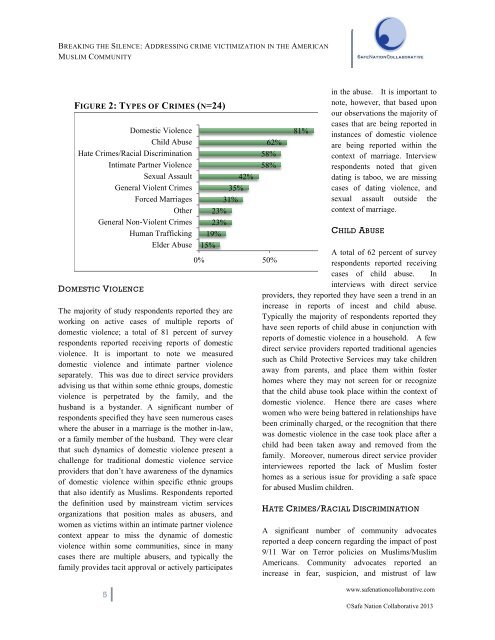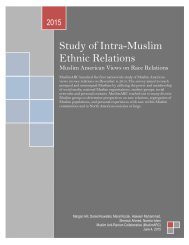Breaking-the-Silence
Breaking-the-Silence
Breaking-the-Silence
You also want an ePaper? Increase the reach of your titles
YUMPU automatically turns print PDFs into web optimized ePapers that Google loves.
BREAKING THE SILENCE: ADDRESSING CRIME VICTIMIZATION IN THE AMERICAN<br />
MUSLIM COMMUNITY<br />
FIGURE 2: TYPES OF CRIMES (N=24)<br />
Domestic Violence<br />
Child Abuse<br />
Hate Crimes/Racial Discrimination<br />
Intimate Partner Violence<br />
Sexual Assault<br />
General Violent Crimes<br />
Forced Marriages<br />
O<strong>the</strong>r<br />
General Non-Violent Crimes<br />
Human Trafficking<br />
Elder Abuse<br />
DOMESTIC VIOLENCE<br />
42%<br />
35%<br />
31%<br />
23%<br />
23%<br />
19%<br />
15%<br />
The majority of study respondents reported <strong>the</strong>y are<br />
working on active cases of multiple reports of<br />
domestic violence; a total of 81 percent of survey<br />
respondents reported receiving reports of domestic<br />
violence. It is important to note we measured<br />
domestic violence and intimate partner violence<br />
separately. This was due to direct service providers<br />
advising us that within some ethnic groups, domestic<br />
violence is perpetrated by <strong>the</strong> family, and <strong>the</strong><br />
husband is a bystander. A significant number of<br />
respondents specified <strong>the</strong>y have seen numerous cases<br />
where <strong>the</strong> abuser in a marriage is <strong>the</strong> mo<strong>the</strong>r in-law,<br />
or a family member of <strong>the</strong> husband. They were clear<br />
that such dynamics of domestic violence present a<br />
challenge for traditional domestic violence service<br />
providers that don’t have awareness of <strong>the</strong> dynamics<br />
of domestic violence within specific ethnic groups<br />
that also identify as Muslims. Respondents reported<br />
<strong>the</strong> definition used by mainstream victim services<br />
organizations that position males as abusers, and<br />
women as victims within an intimate partner violence<br />
context appear to miss <strong>the</strong> dynamic of domestic<br />
violence within some communities, since in many<br />
cases <strong>the</strong>re are multiple abusers, and typically <strong>the</strong><br />
family provides tacit approval or actively participates<br />
62%<br />
58%<br />
58%<br />
81%<br />
in <strong>the</strong> abuse. It is important to<br />
note, however, that based upon<br />
our observations <strong>the</strong> majority of<br />
cases that are being reported in<br />
instances of domestic violence<br />
are being reported within <strong>the</strong><br />
context of marriage. Interview<br />
respondents noted that given<br />
dating is taboo, we are missing<br />
cases of dating violence, and<br />
sexual assault outside <strong>the</strong><br />
context of marriage.<br />
CHILD ABUSE<br />
A total of 62 percent of survey<br />
0% 50% 100% respondents reported receiving<br />
cases of child abuse. In<br />
interviews with direct service<br />
providers, <strong>the</strong>y reported <strong>the</strong>y have seen a trend in an<br />
increase in reports of incest and child abuse.<br />
Typically <strong>the</strong> majority of respondents reported <strong>the</strong>y<br />
have seen reports of child abuse in conjunction with<br />
reports of domestic violence in a household. A few<br />
direct service providers reported traditional agencies<br />
such as Child Protective Services may take children<br />
away from parents, and place <strong>the</strong>m within foster<br />
homes where <strong>the</strong>y may not screen for or recognize<br />
that <strong>the</strong> child abuse took place within <strong>the</strong> context of<br />
domestic violence. Hence <strong>the</strong>re are cases where<br />
women who were being battered in relationships have<br />
been criminally charged, or <strong>the</strong> recognition that <strong>the</strong>re<br />
was domestic violence in <strong>the</strong> case took place after a<br />
child had been taken away and removed from <strong>the</strong><br />
family. Moreover, numerous direct service provider<br />
interviewees reported <strong>the</strong> lack of Muslim foster<br />
homes as a serious issue for providing a safe space<br />
for abused Muslim children.<br />
HATE CRIMES/RACIAL DISCRIMINATION<br />
A significant number of community advocates<br />
reported a deep concern regarding <strong>the</strong> impact of post<br />
9/11 War on Terror policies on Muslims/Muslim<br />
Americans. Community advocates reported an<br />
increase in fear, suspicion, and mistrust of law<br />
5<br />
www.safenationcollaborative.com<br />
©Safe Nation Collaborative 2013



